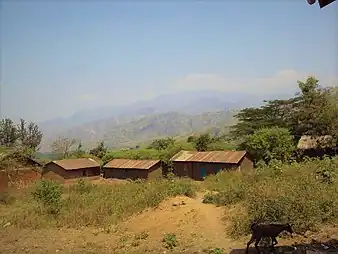Lubarika
Lubarika is a village situated in the hills and high plateaus of Bafuliiru Chiefdom in Uvira Territory, located in the South Kivu Province in the eastern part of the Democratic Republic of Congo (DRC). It sits at an elevation of 969 meters above sea level and is near the villages of Murunga and Nyakagobe II. Lubarika is a predominantly agricultural region with large hectares used for subsistence agriculture. Agriculture is practiced by an extensive segment of the population. The products grown are mainly intended for domestic consumption and commercialization (with or without a minimum percentage of seed reserves). Moreover, fishing is carried out artisanally in Lake Tanganyika by the local population.[1][2][3]

The village is occupied by the Fuliiru and Vira people, Bantu-speaking people who live on the high plateaus situated to the east of the DRC.[4][5][6]
History
Lubarika was traditionally inhabited by Fuliiru people.[7] In the 1940s, during the Belgian colonial era, Lubarika was popular due to its mild climate and being a cotton-growing region based mainly on forced labour that spanned from Ruzizi Plain and reached as far as south, north and west areas of the Democratic Republic of the Congo.[8][9][10]
At the commencement of the First Congo War, on October 18, 1996, Lubarika was attacked by the AFDL (Alliance des Forces Démocratiques pour la Libération du Congo-Zaïre), the APR, and the FAB (Forces Armées Burundaises). Thousands of Rwandan refugees as well as Zairian civilians were killed in Lubarika when AFDL attacked Zaire from neighboring Uganda and Rwanda. Among these refugees were a large number of women and children, ex-FAR/Interahamwe soldiers, who had just been defeated, and political and administrative authorities who supervised the Rwandan Genocide.[11] Many Rwandan refugees, as well as Zairian civilians, fled the village as AFDL troops were on a rampage of killing anyone in sight. Those who attempted entry into Kakumbukumbu, a village five kilometers from Lubarika, were captured and killed by AFDL troops.[12]
After the massacres against Rwandan refugees and Zairian civilians during the First and Second Congo Wars, several articles and international academic research have been devoted to the mass violence against Rwandan refugees and Congolese civilians. These scholarly research and data led the UN High Commissioner for Human Rights to write and publish a report entitled "Mapping Report" on the "most serious violations of human rights and international humanitarian law committed within the territory of the Democratic Republic of the Congo between March 1993 and June 2003".[13][14][11]
See also
References
- Helgeson, Earl A.; Food and Agriculture Organization of the United Nations; Kosikowski, Frank; Parsons, Kenneth H.; Joshi, N. R.; Mocquot, Germain (1957). The Owner Cultivator in a Progressive Agriculture: An FAO Land Tenure Study, Volumes 36-40. Urbana and Champaign, Illinois, United States: The University of Illinois Urbana-Champaign. pp. 148–150.
- "MONOGRAPHIE DE LA CHEFFEERIE DES BAFULIIRU". www.africmemoire.com. Retrieved 2023-06-27.
- "Annuaire des rues de Bafuliro (chefferie), Uvira". rues-rd-congo.openalfa.com (in French). Retrieved 2023-06-27.
- "Rapport final: des consultations participatives de la base pour l'élaboration du Document de Stratégies de Réduction de la Pauvreté (DSRP), Territoire de UVIRA - Province du Sud Kivu" (PDF). The University of Texas at Austin (in French). 2004. pp. 9–10. Retrieved 2023-04-14.
- Verweijen, Judith (January 2016). "A Microcosm of Militarization" (PDF). Rift Valley Institute | Usalama Project. p. 15. Retrieved 2023-04-14.
- Traveller's Guide to the Belgian Congo and Ruanda-Urundi. Ann Arbor, Michigan: The University of Michigan. 1956. p. 446.
- Kapapi, John (March 28, 2019). Lies of the Tutsi in Eastern Congo/Zaire: A Case Study: South Kivu (Pre-Colonial to 2018). United States. pp. 55–57.
{{cite book}}: CS1 maint: location missing publisher (link) - Cotton Growing Review, Volumes 23-24. Ithaca, NY: Cornell University. 1946. p. 201.
- "Cotton Growing in the Belgian Congo". Journal of the Textile Institute Proceedings and Abstracts. 12 (4): 110. 1921-04-01. doi:10.1080/00405002108631021. ISSN 0368-4504.
- M., G. B. (1950). "The Agricultural Development of the Belgian Congo". The World Today. 6 (8): 348–354. ISSN 0043-9134. JSTOR 40392344.
- "Report of the Mapping Exercise documenting the most serious violations of human rights and international humanitarian law committed within the territory of the Democratic Republic of the Congo between March 1993 and June 2003" (PDF). August 2010. p. 91. Retrieved 2023-04-14.
- "Attacks against Hutu refugees – Uvira territory (South Kivu)". Retrieved 2023-04-14.
- "DRC: Mapping human rights violations 1993-2003". OHCHR. Retrieved 2023-04-14.
- "UN Mapping Report". Friends of the Congo. Retrieved 2023-04-14.